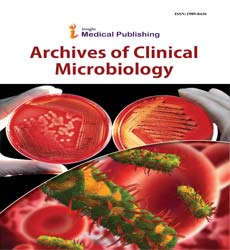Abstract
Changing Epidemiology of Superficial Fungal Infections in Enugu, South East Nigeria
Background: Superficial fungal infections are encountered worldwide but predominate in low and middle in-come countries. It has a high morbidity rate and affects the quality of life. Its epidemiology is changing because of influence of socioeconomic factors, modern life style, immunosuppressive therapy, travel and migration of populations. This study was carried out with the aim to survey the changing epidemiology of superficial fungal infection in Enugu, South East Nigeria.
Methods: This was a hospital based cross-sectional study, carried out in the Department of Medical Microbiology, University of Nigeria Teaching Hospital Enugu. Information regarding the age, sex, preliminary diagnosis and site of infections were gotten from the patients records. A total of 566 clinical specimens were collected from the patients diagnosed with superficial mycosis. The specimens were collected unto a piece of white paper and examined microscopically using potassium hydroxide. They were then cultured on Sabouraud Dextrose Agar (SDA) and incubated at 25°C and 37°C for one month. Fungi identification was based on macroscopic and microscopic examination.
Results: Out of 253 fungi isolated from the clinical specimens, 141 (55.7%) were dermatophytes, with the least being Candida species 32 (12.6%) (Kruskal- Wallis H (6)=4.571; P=0.102). Females: male ratio was 1.3:1. Above 25 years, the isolates were higher in female. (χ2=21.249, P=0.003). Among the dermatophytes, Trichophyton soudanense 56 (22.1%) was the predominant isolate, followed by Trichophyton rubrum 51 (20.16%). (χ2=5.056; P=0.034). The predominant non- dermatophytes isolated were Cladosporum Species 48 (18.0%). The trunk 112 (44.3%) was the most affected site, with the least affected site being the hand 4 (1.6%).
Conclusion: The high rate of previously rare fungi isolated calls for serious surveillance. This study reflects the changing trend of superficial fungal infection with a high rate of isolation of non-dermatophyte.
Author(s):
Nwafia IN, Ohanu ME, Ebede SO, Okoli CE, Emeribe S, Nwachukwu PT
Abstract | Full-Text | PDF
Share this

Abstracted/Indexed in
- Google Scholar
- Open J Gate
- Genamics JournalSeek
- The Global Impact Factor (GIF)
- Open Archive Initiative
- China National Knowledge Infrastructure (CNKI)
- Scimago
- Directory of Research Journal Indexing (DRJI)
- WorldCat
- Proquest Summons
- Publons
- MIAR
- ResearchGate
- University Grants Commission
- Geneva Foundation for Medical Education and Research
- Secret Search Engine Labs
Open Access Journals
- Aquaculture & Veterinary Science
- Chemistry & Chemical Sciences
- Clinical Sciences
- Engineering
- General Science
- Genetics & Molecular Biology
- Health Care & Nursing
- Immunology & Microbiology
- Materials Science
- Mathematics & Physics
- Medical Sciences
- Neurology & Psychiatry
- Oncology & Cancer Science
- Pharmaceutical Sciences

